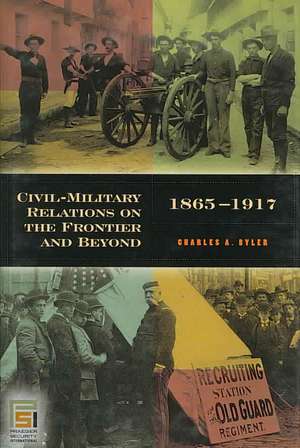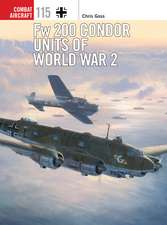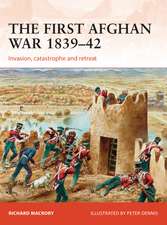Civil-Military Relations on the Frontier and Beyond, 1865-1917: In War and in Peace: U.S. Civil-Military Relations
Autor Charles A. Byleren Limba Engleză Hardback – 29 iun 2006 – vârsta până la 17 ani
Preț: 321.73 lei
Preț vechi: 392.14 lei
-18% Nou
Puncte Express: 483
Preț estimativ în valută:
61.58€ • 66.91$ • 51.76£
61.58€ • 66.91$ • 51.76£
Carte tipărită la comandă
Livrare economică 21 aprilie-05 mai
Preluare comenzi: 021 569.72.76
Specificații
ISBN-13: 9780275985370
ISBN-10: 0275985377
Pagini: 224
Dimensiuni: 156 x 235 x 23 mm
Greutate: 0.51 kg
Editura: Bloomsbury Publishing
Colecția Praeger
Seria In War and in Peace: U.S. Civil-Military Relations
Locul publicării:New York, United States
ISBN-10: 0275985377
Pagini: 224
Dimensiuni: 156 x 235 x 23 mm
Greutate: 0.51 kg
Editura: Bloomsbury Publishing
Colecția Praeger
Seria In War and in Peace: U.S. Civil-Military Relations
Locul publicării:New York, United States
Notă biografică
CHARLES A. BYLER is Associate Professor of History at Carroll College.
Cuprins
IllustrationsSeries ForewordPrefaceChronology of Important Events1 Americans Look at Their Military, 1865-19172 Congress, Popular Opinion, and the Making of Military Policy3 The Military Experience, 1865-19174 "An Animated Machine": Military Subordination to Civil Authority5 Civil-Military Relations and the Campaign for Military Reform6 Military Disaffection and Challenges to Civil AuthorityDocumentsNotesBibliographical EssayIndex
Recenzii
Studies of peacetime military history seem to center around the dichotomy of a wartime force dealing with peacetime existence, and Byler's book is no exception. His thorough examination of the post-Civil War military centers on the opposite demands and desires of the US military and those charged with its political oversight. Byler does an excellent job of summarizing the bewildering variety of tasks that Congress thrust upon the military after the Civil War, while also detailing the mutually suspicious relationship between the military and that same Congress. He describes a military that existed in an uncertain environment. On one hand, Congress and the president considered the military necessary to defend against enemies, both foreign and domestic; on the other hand, they stymied the professional development that kept the military viable in a rapidly changing world. Added to this was an officer class that increasingly felt justified in resisting political controls, battling a Congress holding the traditional belief that the officer class represented an elite threat to democracy. Although brief (161 pages of text), Byler's work provides an outstanding history of the civil-military relationship. Highly recommended. All academic levels/libraries.
In this useful broad overview of the major developments in civil-military relations during the period, Charles A. Byler outlines the concerns of civilians, soldiers, sailors, and politicians that accompanied this transformation, recounts the major debates in which those concerns manifested, and describes the compromises made and reforms adopted that preserved civilian control of a larger and more professional U.S. military..[t]his well-written and wide-ranging survey provides an excellent introduction to American civil-military relations during an important period.
Blending secondary and printed primary sources, Byler succeeds admirably in compiling a useful synthesis of existing scholarship regarding civil-military relations in the United States between 1865 and 1917. Non-military historians of the period will find Byler's work a convienent introduction into the American armed forces, thus making easier the reintegration of the army and navy into more general academic studies. A useful chronology and eleven primary source documents illustrate the complexities of the civil-military relationships also support the work's broad appeal..[h]is willingness to deal with both the army and navy should encourage students ot these respective branches to step out of their narrow fields and adopt more expansive approaches to their own scholarship..[a] careful and sound overview, stressing the fitful and uneven changes wrought by evolution, not revolution.
The period between the Civil War and World War I was one of major transformation and growth for the US military. In this work, Byler provides a broad overview of changes and continuities in civil-military relations during this period in the form of thematic chapters discussing public views of the military, military-congressional relations, the experiences of officers and enlisted men (in particular looking at desertion, officer promotions, and the role of African Americans in the military), the military's acceptance of the principle of civilian supremacy, military lobbying for the creation of a general staff for the army and the navy, and discontent within the military regarding the political system and other aspects of civil society.
In this useful broad overview of the major developments in civil-military relations during the period, Charles A. Byler outlines the concerns of civilians, soldiers, sailors, and politicians that accompanied this transformation, recounts the major debates in which those concerns manifested, and describes the compromises made and reforms adopted that preserved civilian control of a larger and more professional U.S. military..[t]his well-written and wide-ranging survey provides an excellent introduction to American civil-military relations during an important period.
Blending secondary and printed primary sources, Byler succeeds admirably in compiling a useful synthesis of existing scholarship regarding civil-military relations in the United States between 1865 and 1917. Non-military historians of the period will find Byler's work a convienent introduction into the American armed forces, thus making easier the reintegration of the army and navy into more general academic studies. A useful chronology and eleven primary source documents illustrate the complexities of the civil-military relationships also support the work's broad appeal..[h]is willingness to deal with both the army and navy should encourage students ot these respective branches to step out of their narrow fields and adopt more expansive approaches to their own scholarship..[a] careful and sound overview, stressing the fitful and uneven changes wrought by evolution, not revolution.
The period between the Civil War and World War I was one of major transformation and growth for the US military. In this work, Byler provides a broad overview of changes and continuities in civil-military relations during this period in the form of thematic chapters discussing public views of the military, military-congressional relations, the experiences of officers and enlisted men (in particular looking at desertion, officer promotions, and the role of African Americans in the military), the military's acceptance of the principle of civilian supremacy, military lobbying for the creation of a general staff for the army and the navy, and discontent within the military regarding the political system and other aspects of civil society.



















